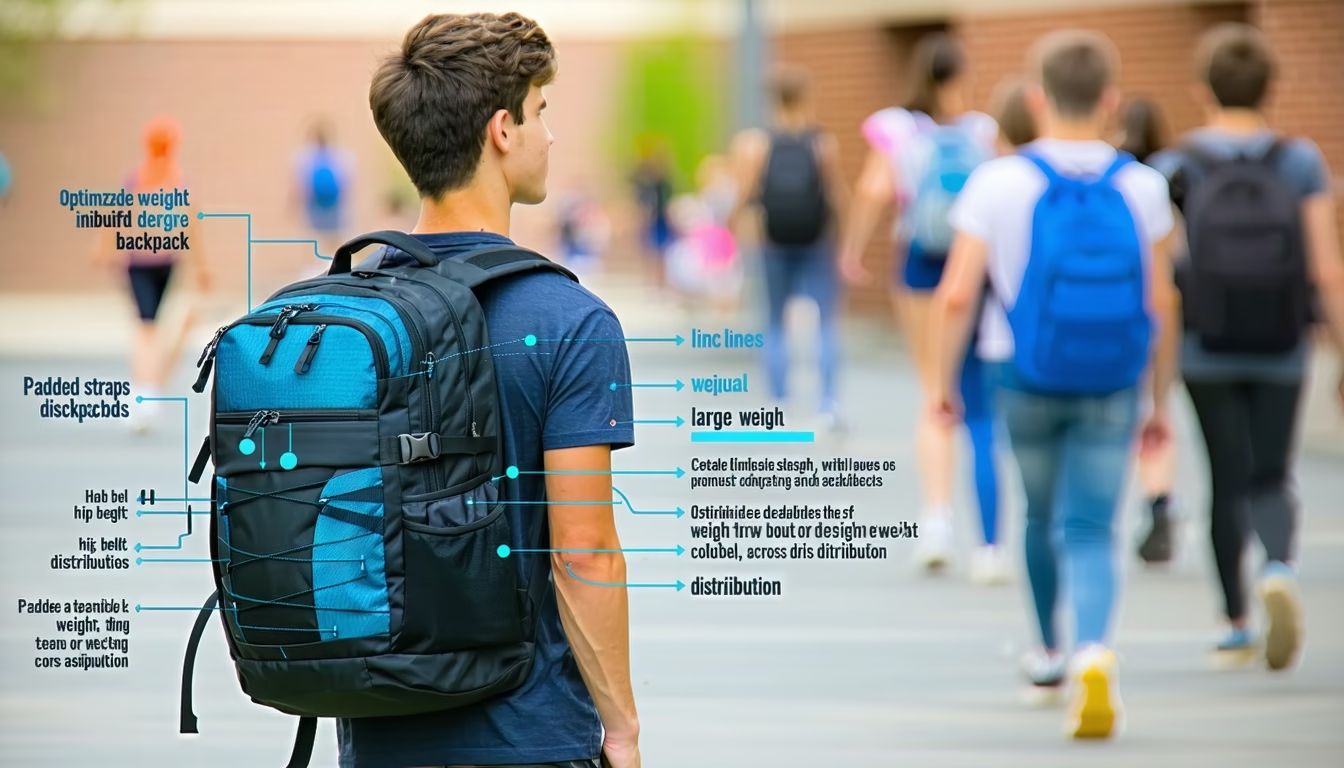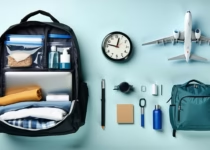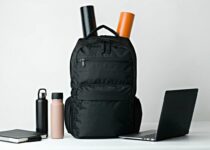Optimizing Weight Distribution in Large Backpacks For Teens

Understand Weight Distribution
Imagine walking into class and not hearing your backpack groan with every step. If you’ve ever wondered about optimizing weight distribution in large backpacks for teens, you’re not alone. Carrying an unbalanced load can lead to shoulder strain, back pain, and poor posture. Here’s the thing, with a few simple tweaks you can turn that bulky pack into a comfy carry-all.
Key Promise: By spreading weight smartly, you’ll reduce fatigue and protect your spine through every school day.
Weight Zones Explained
Backpacks naturally break into three zones:
- Top Zone: Light items like pencil cases, calculators, or sunglasses
- Middle Zone: Heaviest gear such as textbooks, laptops, or binders
- Bottom Zone: Bulky but lighter things like lunch bags or gym clothes
Keeping the heavy stuff close to your back in the middle zone helps maintain your center of gravity. If you stack weight too far away, your shoulders bear more stress and you lean forward unconsciously.
Why It Matters for Teens
Your body is still growing so uneven loads can cause muscle imbalances over time. Poor weight distribution often leads to slouching or leaning to one side. Ever felt like your backpack is pulling you backwards? Proper balance stops that tug, letting you move naturally between classes.
Choose the Right Backpack Fit
A well-packed bag only works if the backpack matches your body. Even the coolest design won’t help if it doesn’t fit your frame just right.
Measuring Torso and Frame
- Stand straight against a wall
- Mark the top of your shoulders and the curve of your lower back
- Measure the distance between those points—you’ve got your torso length
Most teen backpacks list recommended torso measurements. Match your number to the bag’s sizing chart for a snug fit that won’t slide down.
Adjusting Straps for Support
After choosing the right size, tweak these straps:
- Shoulder Straps: Tighten until the pack sits 1–2 inches below your shoulders
- Sternum Strap: Clip and adjust so it rests across your chest—low enough not to restrict breathing
- Hip Belt (if available): Fasten around your hips, not your waist, to shift up to 50 percent of weight off your shoulders
Table: Strap Adjustment Guidelines
| Strap Type | Position Relative to Body | Effect on Weight Distribution |
|---|---|---|
| Shoulder Straps | 1–2 inches below shoulders | Keeps load close to spine |
| Sternum Strap | Mid-chest, not high under neck | Stabilizes shoulder straps |
| Hip Belt | Around pelvic bone | Transfers weight off shoulders |
Correct strap setup prevents the pack from bouncing or sliding, so your spine stays aligned and you feel less fatigue.
Pack Strategically
Think of packing like stacking blocks—you want a stable base, solid core, and lighter pieces on top. That way your load won’t shift when you bend or sprint for the bus.
Core Packing Principles
- Use Every Compartment: Front pockets for small items, side pouches for water bottles, main compartment for books
- Distribute Evenly: Place equally heavy objects side by side to avoid lopsided pulls
- Keep Essentials Accessible: Items you grab often—like your phone or keys—should live in easy-reach pockets
Layering Items by Weight
- Heaviest Items Close to Your Back
- Textbooks, binders, laptops
- Medium Items in the Middle
- Notebooks, folders, lunch bags
- Light Items on Top
- Pens, snacks, sunglasses
This layering strategy stabilizes your center of gravity. When the heavy stuff nestles near your back, it won’t sag downwards or pull you backward.
Balancing Left to Right
Quick Check: Zip up your pack, then place it on a table. If it tips to one side you know something’s too heavy there. Slide items across compartments until it sits flat.
For more small-item ideas, check our guide on organizing earbuds and small tech in teen backpacks. You’ll keep gadgets from rattling around and throwing off your balance.
Use Accessories for Stability
Adding a few gear extras can make a big difference in how your backpack handles loads. Think of them as little helpers that lock everything in place.
Compression Straps and Load Lifters
Many large backpacks include compression straps on the sides. Tightening these straps:
- Compresses bulky items into a tighter bundle
- Reduces shifting when you move
- Lowers the pack’s profile for closer-quarters
Load lifter straps (found near the top of the shoulder straps) tilt the pack toward your body. That angle keeps weight from pulling you backwards on hills or during quick turns.
Packing Cubes and Dividers
Packing cubes aren’t just for suitcases—they work wonders inside backpacks too. Use them to:
- Segregate heavy gear from lighter clothes
- Quickly swap cubes between bags
- Prevent individual items from sliding
Flexible dividers inside the main compartment also let you create snug slots for books or binders. You support that heavy load and keep it from gong around.
Hydration Systems
Staying hydrated helps you avoid slouching when you get tired. If you like sipping water hands-free, consider a backpack with an in-built hydration bladder or straw system. For more on this option, see our review of teen backpacks with built-in hydration straw systems.
Enhance Comfort During Wear
Even with perfect packing and straps, you’ll need to check in with your body to stay pain free all day.
Preventing Shoulder and Back Strain
- Add a Foam Pad: A thin foam sheet between you and the pack smooths out bumps
- Wear a Base Layer: A moisture-wicking shirt prevents chafing under straps
- Switch Shoulders: Every now and then, shift weight slightly by loosening one strap and tightening the other
Taking Breaks and Posture Checks
Ever realize you’re rounding your shoulders after 20 minutes? Set a reminder on your phone or watch. Every period or block, pause to:
- Stand tall
- Pull shoulders back
- Re-adjust straps if needed
Good posture supports your spine naturally and keeps muscles balanced. For more on carrying your pack correctly, peek at our overview of teen backpacks and back posture proper way to wear.
Select Backpacks With Helpful Features
When shopping for a new pack, keep an eye out for features that make balancing loads easier.
Frame Types and Back Panels
- Internal Frames: Light metal or plastic stays built into the pack, offering shape and support
- External Frames: Visible metal frames, ideal for very heavy loads but less streamlined
- Back Panel Materials: Breathable mesh panels wick moisture and keep the pack snug, while padded panels offer extra cushion
If you’re torn between mesh and extra padding, check our comparison of breathable mesh vs padded back panels for teenage backpacks.
Pockets and Compartment Styles
Look for:
- Stretch Side Pockets: Hold water bottles or small tripods securely
- Front Sleeves: Perfect for stashing folders or slim laptops for quick access
- Hidden Pocket: Great for valuables like your phone or wallet
A well-thought pocket layout helps you balance weight by giving every item its own snug home.
Maintain and Clean Your Pack
A clean, well-kept backpack performs better and lasts longer. Neglected dirt and wear can weaken fabric and straps.
Inspecting Straps and Seams
Every month:
- Check Stitching: Loose threads can lead to ripped seams
- Test Buckles: Make sure clips latch securely without slipping
- Examine Zippers: Smooth zippers keep compartments sealed tight
If you spot minor issues, you can often fix them yourself—learn how in our minor repairs every teen girl should DIY on her backpack.
Cleaning and Freshening
- Empty All Pockets and Shake Out Debris
- Spot Clean Stains With Mild Soap and Warm Water
- Air Dry Completely, Inside and Out
For a quick scent boost between washes, try making a simple sachet style freshener—find recipes in our DIY backpack air fresheners for teenage school bags.
FAQs
1. How much weight should I carry in my teen backpack?
Most experts recommend keeping your load under 10 to 15 percent of your body weight to avoid strain.
2. Can I use packing cubes in a school backpack?
Yes. Packing cubes help organize books, clothes, and snacks to prevent items from shifting around.
3. Should the hip belt rest on my waist or hips?
It should sit on your pelvic bones, not your waist. That position transfers weight to your hips and legs.
4. How often should I adjust my backpack straps?
Re-adjust every time you add or remove heavy items and check your fit each month for growth spurts.
5. Is a frame backpack better than a frameless one?
Internal frame packs offer structure for heavier loads, while frameless packs are lighter. Pick based on your typical weight.
6. What’s the easiest way to keep my pack smelling fresh?
Use a small sachet of baking soda and a few drops of essential oil in a hidden pocket, replacing it every few weeks.
7. How do I prevent textbooks from bending?
Place them upright against the back panel and use dividers or a front sleeve for extra support.
Conclusion
Optimizing weight distribution in your large teen backpack isn’t rocket science, but it does take a few mindful steps. Measure your torso, adjust straps, pack smartly, and choose features that support your style of carrying. By keeping the heavy stuff close, using accessories, and checking in with your posture, you’ll breeze through hallways without that dreaded backache. Now grab your pack, try one tip today, and feel the difference from day one.


